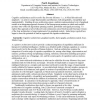1772 search results - page 103 / 355 » The Model Coupling Toolkit |
JCNS
2006
14 years 11 months ago
2006
"Equation-free modelling" is a recently-developed technique for bridging the gap between detailed, microscopic descriptions of systems and macroscopic descriptions of the...
CORR
2004
Springer
14 years 11 months ago
2004
Springer
We propose a model for the World Wide Web graph that couples the topological growth with the traffic's dynamical evolution. The model is based on a simple traffic-driven dynam...
112
click to vote
COGSR
2011
14 years 6 months ago
2011
Cognitive architectures need to resolve the diversity dilemma – i.e., to blend diversity and simplicity – in order to couple functionality and efficiency with integrability, e...
DATE
2006
IEEE
15 years 5 months ago
2006
IEEE
Abstract: DRAMs play an important role in the semiconductor industry, due to their highly dense layout and their low price per bit. This paper presents the first framework of faul...
PARA
2004
Springer
15 years 4 months ago
2004
Springer
We describe the parallelization of an efficient algorithm for balanced truncation that allows to reduce models with state-space dimension up to O(105 ). The major computational tas...



